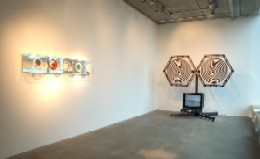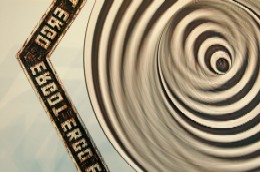#13 VERTIGO : Marcel Duchamp and Mark Titchner
Curated by Donald Smith
21.03.07 - 28.04.07
press release | images | reviews | links | publication | private view | invitation
Featuring Marcel Duchamp's Rotoreliefs and Mark Titchner's Ur Text
The chapel of transcendental domestic experience is closed until further notice.
My first experience of rotoscopic art came with a battered copy of Black Sabbath's "Master of Reality" bought one Saturday morning on Dunstable market. The trembling Vertigo records label surrounded by a starless night of vinyl seemed the perfect partner to songs like "After Forever" and "Into the void". I could watch that thing spinning for hours on end, rising and falling into its abyss. Not really knowing what it was or how it worked but knowing that it did something strange that I had only experienced before by rubbing my eyes very hard or during some childhood fever intensified by the crazy silver wallpaper in the front room. (Eventually I got the sense it was a door marked "EXIT".)
Years later I first came across Marcel Duchamp's Rotoreliefs and of course the connection was made. This was the progenitor of my beloved gyrating friend whose commercial failure at alley F, Stand 147 of the 1935, 33rd Concours Lepine, had at least been slightly alleviated by the mass-market familiarity of the Vertigo design.
The Vertigo label represented a distillation of Duchamp's concept to its bare optical bones and much is lost in the process. Duchamp seems to suggest two kinds of shows for this private channel; firstly a kind of drunken domestic comedy where goldfish, poached eggs and standard lamps form the constellation of some bed-sit world - eternal return in the land of dirty dishes with an absinthe chaser. The other kind of programming seeks to take us away from the banality of the world of objects and directly into the cosmos of the infinite spirals and panoptical eyes. However, take note, whatever you choose to watch you do it from the same chair.
And again a few years later the trail continued when I finally came across Brion Gysin and Ian Sommerville's Dreamachine, a transcendental magic lantern for the purposes of internal cinematography. Simple and cheap to make, a drugless high, that functioned by using the electrical activity of the greatest readymade of all, the human brain. This marvel also continued and expanded the logic of Duchamp's 'non retinal' art for it was designed to be used with your eyes closed. Users described walls of fire and archetypal visions, here were optics in the service of the absolute.
Scene and Setting. All roads lead back to the front room. These objects provide an understanding of the potential of the domestic as a site for something other than the daily drip, drip, drip of the TV set. They lead us to a space that has yet to be branded or compromised by market shares. Though given the all-pervasive nature of it, it is possible that a new generation of Dreamachine users might find all to familiar logos and slogans creeping into their eyelid movies. Let's hope not and for the moment let's just imagine a little white light from the eye of the infinite beaming into homes around the world.
Our slogan."And it's all free."
Mark Titchner, March 2007
For more information on Mark Titchner please visit the Vilma Gold website.
A CHELSEA space pamphlet including an interview between Mark Titchner and Lisa Le Feuvre will accompany the exhibition.




